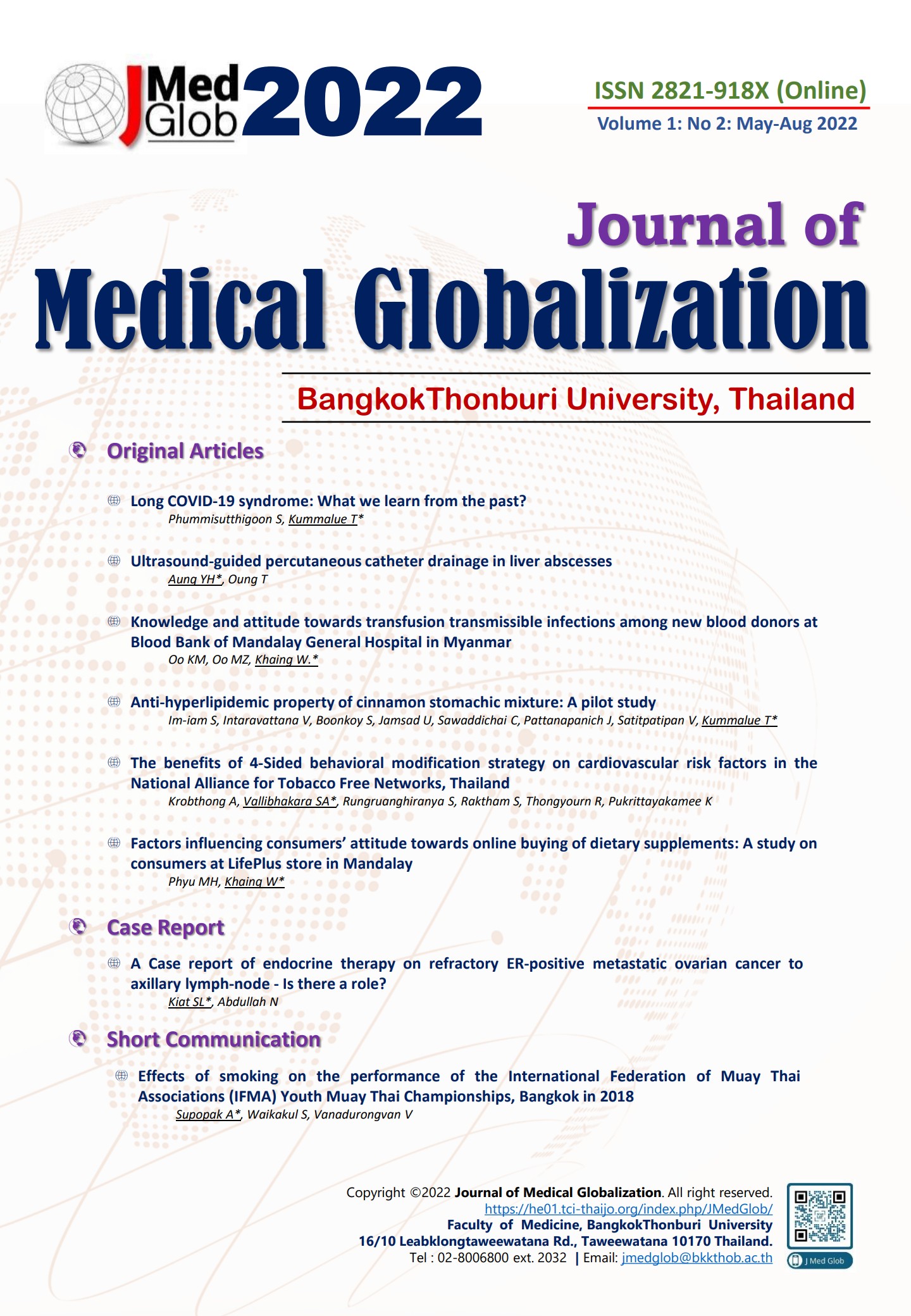The Benefits of 4-Sided Behavioral Modification Strategy on Cardiovascular Risk Factors in the National Alliance for Tobacco Free Networks, Thailand
Keywords:
NCDs, Behavioral Modifications, Risk modification, Cardiovascular risk, Change4HealthAbstract
Background: Non-communicable diseases (NCDs) are the critical cause of morbidity and mortality in Thailand. Medical treatment and lifestyle modifications are indicated to control the disease. However, the efficacy of lifestyle modification programs is still not clearly revealed. Objective: To estimate and report on the effectiveness of health-risk behavior modification programs, called the "Change 4 Health" Strategy, on health outcomes in the National Alliance for Tobacco Free, Thailand.
Methods and Materials: "Change 4 Health" programs use mnemonics to change four bad habits: A-Avoiding Alcohol, B-Body Movement, C-Cessation, and D-Diet. Results aimed to retrieve the summary and secondary data from the database. Thailand's National Alliance for Tobacco Free (THPAAT) offers basic, easy-to-follow behavior workshops. We reviewed 1,815 quality records and qualitative data from 20 Bangkok primary care units. Changes in health risk behaviors were tracked 1 and 3 months after "Change4Health" was implemented. Changes in cardiovascular risk factors, alcohol intake, smoking cessation, exercise, and eating behaviors and diets were statistically significant at a p-value of 0.05.
Results: THPAAT's "Change 4 Health" technique helped populations quit smoking, improve their dietary habits, exercise more, and reduce alcohol consumption by 45%, 47.8%, 11.8%, and 15.8%, respectively. One-third (31.3%) reported weight loss. Nearly one-fifth (16.3%) reduced their waist circumference. These effects were linked to eating and smoking (p-value <0.01). Smoking cessation and exercise reduced blood pressure monitoring by 15.3%. Dextrostix found that glucose levels improved by 55.2%, which was strongly linked to eating behavior. One-third of LDL values dropped after eating and smoking cessation (p-value <0.01). Reducing alcohol consumption improved health indicators (body weight, waist circumference, blood pressure, blood sugar, and LDL) by 15.85% (p-values >0.05).
Conclusion: A health-risk behavior modification program called Change 4 Health (Avoid Alcohol, B-Body movement, C-Cessation, D-Diet) improved health indexes among participants. However, smoking cessation and diet changes appeared to be the most effective way to change physical parameters, including body weight, Waist circumferences, and have some effect on blood sugar and lipid level.
References
Bundhamcharoen K, Odton P, Phulkerd S, Tangcharoensathien V. Burden of disease in Thailand: changes in health gap between 1999 and 2004. BMC Public Health 2011;11:53.
World Health Organization. Global status report on non-communicable diseases 2014. [Internet] 2014 [cite 2022 Aug 10]. Available from: https://apps.who.int/iris/handle/10665/148114
Thanarung, P., Thongprong,P., Phonphol,A. The study of risk behaviors and risk factors of the population in Nong Hai Village. Academic conferences and national research presentations in The National Conference and Research Presentation "Create and Development to Approach ASEAN Community II" 2015;2:102-109.
Srivanichakorn, S. Morbidity and mortality situation of non-communicable diseases (diabetes type 2 and cardiovascular diseases) in Thailand during 2010-2014. Dis Control J 2017;43:379-90.
Department of health, Ministry of Public health. Non-communicable disease situation. [Internet] 2017 [cite 2022 Aug 2]. Avaiable from: http://hp.anamai.moph.go.th/ewt_dl_link.php?nid=3017
Division of Non-Communicable Diseases. NCD Disease Situation Report 2019. [Internet] 2019 [cite 2022 Aug 2]. Avaiable from: http://www.thaincd.com/document/file/download/knowledge/NCDs63update.pdf
Chaipet N, Kaewklum U, Sonrat S, Wittayapun Y. Non Communicable Diseases (NCD's) High Risk Patients: Effectiveness of a Health Behaviors Changing Programs on Health Behavior in Suratthani. SCNJ 2017; 2: 45-62.
Srawut Donpradid S. The Development of a Health Promotion Model for Prevention and Control of Diabetes and Hypertension among Elderly People Who Live in Rural Community. JHSCPH 2019; 1: 108-22.
Stewart KJ, Bacher AC, Turner KL, Fleg JL, Hees PS, Shapiro EP, Tayback M, Ouyang P. Effect of exercise on blood pressure in older persons: a randomized controlled trial. Arch Intern Med. 2005;165(7):756-62
Verma A, Mehta S, Mehta A, Patyal A. Knowledge, attitude and practices toward health behavior and cardiovascular disease risk factors among the patients of metabolic syndrome in a teaching hospital in India. J Family Med Prim Care. 2019;8(1):178-183.
Sarkar A, Rathod M, Patel N, Chauhan M, Makwana N, Parmar D. A Cross-Sectional Analytical Study of Knowledge and Practice of Exercise among Hypertensive Patients attending NCD Clinic in Western Gujarat. Int J Med Sci Public Health 2018; 8:140-144.
Krobthong A, Rungruanghiranya S,Raktham S,Pukrittayakamee K,Thongyourn R. The effectiveness of implementing "change4health", the health-risk behavior modification programs, among primary care units in Bangkok. Tob Induc Dis 2021 the 13th ASIA PACIFIC conference on Tobacco or health APACT 2021, September 3-4, Bangkok, Thailand ;19 (Suppl 1): A30
Wadden TA, Tronieri JS, Butryn ML. Lifestyle modification approaches for the treatment of obesity in adults. Am Psychol. 2020;75(2):235-251
Jensen MD, Ryan DH, Apovian CM, Ard JD, Comuzzie AG, Donato KA, et al. American College of Cardiology/American Heart Association Task Force on Practice Guidelines; Obesity Society. 2013 AHA/ACC/TOS guideline for the management of overweight and obesity in adults: a report of the American College of Cardiology/American Heart Association Task Force on Practice Guidelines and The Obesity Society. Circulation. 2014;129(25 Suppl 2): S102-38.
Dalle Grave R, Calugi S, El Ghoch M. Lifestyle modification in the management of obesity: achievements and challenges. Eat Weight Disord 2013;18(4):339-49.
Kushima K, Takamoto N, Sato H, Munaka M. Effect of smoking cessation on body mass index, blood pressure and serum lipids in middle-aged male workers. Nihon Koshu Eisei Zasshi. 1998;45(10):1000-10.
Suwazono Y, Dochi M, Oishi M, Tanaka K, Morimoto H, Sakata K. Longitudinal effect of smoking cessation on physical and laboratory findings. Am J Prev Med 2010;38(2):192-200.
Allen SS, Hatsukami D, Gorsline J. Cholesterol changes in smoking cessation using the transdermal nicotine system. Transdermal Nicotine Study Group. Prev Med 1994 ;23(2):190-6.
Published
How to Cite
Issue
Section
License
Copyright (c) 2022 J Med Glob

This work is licensed under a Creative Commons Attribution-NonCommercial 4.0 International License.








